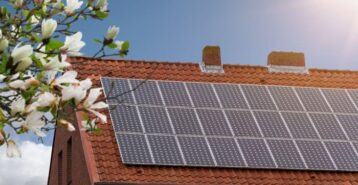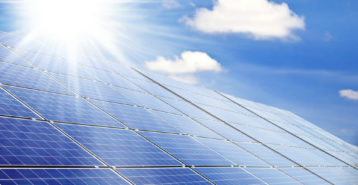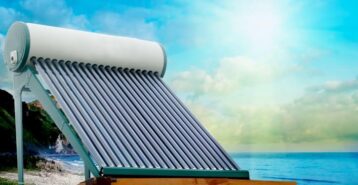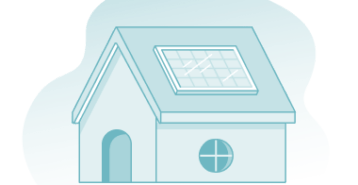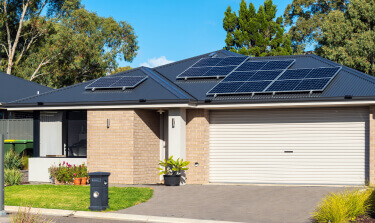Solar energy can be used as a power source for many different areas in your home, including your running water. Solar hot water heaters use sunlight to produce hot water for cooking, bathing, washing dishes and laundry, and much more. By adding a solar water heater to you your home, you can cut utility costs and reduce your carbon footprint—it’s a win-win.
How Do Solar Water Heaters Work?
To understand how solar water heaters work, think of a greenhouse. Greenhouses are glass structures that convert sunlight into heat energy, as sunlight hits the glass. Similarly, solar powered water heaters use sunlight to produce heat energy through solar collectors. Sunlight travels into the solar collector through a glass-plated front panel, where an absorber layer of dark material soaks up the sunlight and generates heat.
The solar collector is insulated to hold that heat in. Then, a heat exchanger or simple copper pipe transfers that heat to the water inside the collector. The process repeats over and over again, continually warming your home’s water source.
Here’s one of the best parts – you don’t have to worry about not having hot water when the sun isn’t out. All the sunlight-heated water collects in an insulated storage tank, keeping it heated for future use.
How Much Do Solar Water Heaters Cost?
The out-the-door cost to install a solar hot water heater in your home depends on a few factors. Factors that influence cost include:
- Type of water heater
- Location of installation
- Size of the heating system (ie. the water tank)
- Permits required
The average U.S. household will pay between $2,500 – $5,500 to have a solar powered water heater installed. This includes labor costs as well as material costs. Passive solar water heaters typically cost a bit less compared to active solar water heaters.
- Active solar water heater installation cost: An average of $2,500 – $4,000
- Passive solar water heater installation cost: An average of $1,000 – $3,000
Keep in mind that there may be additional costs involved with your new solar hot water heater. For instance, if your home requires a larger water tank due to more household members, your installation cost will likely lean towards the higher end of the spectrum.
Types of Solar Water Heaters
In terms of types of solar water heaters, they are categorized by how they circulate and produce hot water. There are two main types of circulation systems used to channel water through a solar heater—passive circulation systems and active circulation systems. Here is the simple difference between the two…
- Passive systems do not use a water pump to move and circulate water.
- Active systems do use a water pump to move and circulate water.
There are also some bigger differences in how the systems can be set up. It is important to understand these key differences if you are planning to install a solar water heater, so you can choose the type that best fits your needs.
Active Circulation Solar Water Heaters
Active circulation systems are popular solar water heaters for residential homes. As mentioned, they use a pump to create hot water and circulate it throughout the home. In general, active circulation systems pump water between your home, the solar collectors, and the storage tanks. Active circulation solar water heaters can use one of two methods to heat water: direct circulation and indirect circulation.
- Direct circulation: Pumps circulate water through solar collectors and into the home, where homeowners can then use the hot water.
- Indirect circulation: Pumps will also circulate water through solar collectors. However, they use a non-freezing heat transfer liquid, which is beneficial for homes in areas with freezing climates.
Pros and Cons
| Pros | Cons |
| Can be positioned in home almost anywhere | More expensive |
| Works well in colder climates | Use an electric heat pump, which requires electricity |
| More efficient in heating water |
Passive Circulation Solar Water Heaters
Compared to active systems, passive circulation water heaters are a bit more complex to set up in terms of how they are built. The water storage tank for the system has to be positioned above the solar collectors in order to heat the water. The system relies on the laws of physics — generated heat naturally rises the storage tank, creating a circulation system that pulls in new cool water.
While passive circulation solar water heaters are generally less expensive compared to active circulation heaters, they work best in mild climates. If you live in an area that tends to freeze in the winters, investing in a passive circulation system is probably not the best idea. However, they do not rely on electric heat pumps to function, meaning they are a more “green” and sustainable source of heat.
Pros and Cons
| Pros | Cons |
| Less expensive than active circulation systems | Not as effective in heating water |
| Last longer than active systems | Works best in mild climates, rather than colder climates |
| Does not require electricity to function | Can be heavy; sometimes need to be installed on the roof |
Solar Water Heater Collector Types
In addition to different water circulation methods, solar hot water heaters also involve different types of solar collectors. As a reminder, the solar collector is the powerhouse of the water heating system — it converts sunlight into heat energy, which in turn produces your home’s hot water.
There are three main types of solar water heater collectors: batch collectors, flat-plate collectors, and evacuated tube collectors. Each functions in different ways and serves different purposes, which is why it’s important to understand them before choosing one.
Batch Collectors
Batch collectors for solar water heaters are designed to heat up “batches” of several gallons of water at a time. They can produce water at very high temperatures and work well for most heating applications.
The basic design of a batch collector is a black tank holding water within an insulated box. Water travels into the tank and back out again. Most of the time, the water movement is completely passive and occurs as the water heats up and cools down.
Pros and Cons
Batch collectors for solar water heaters are less expensive than other types of collectors. However, they can be quite heavy when filled with water. Sometimes, they need to be stored on the roof for extra support. Additionally, note that batch collectors are designed for use in warm climates because they present the risk of freezing during below-zero temperatures.
Flat Plate Collectors
Flat plate collectors for solar water heaters look similar to solar panels and provide heat effectively when the sun is strong. Although rarely more than six inches thick, they do take up a large amount of roof space. A flat plate collector has a single inlet and outlet point — it routes water through a series of small copper pipes to effectively exchange heat to the water moving through them.
Pros and Cons
In terms of both cost and efficiency, flat plate collectors are situated between batch collectors and evacuated tube collectors, which make them the middle-of-the-road choice. However, they’re less effective in windy conditions than evacuated tube collectors, and they lose heat faster in very cold climates.
Evacuated Tube Collectors
Evacuated tube collectors for solar water heaters are known for being the most efficient of the bunch. They work by heating water in a tank through the vacuum tubes mounted beneath.
Pros and Cons
A benefit to using evacuated tube collectors is that they’re successful at generating heat even in cloudy conditions. Plus, they don’t suffer heat loss from wind like other systems do. They also lose heat very slowly in cool conditions, allowing them to create heat in below-freezing climates effectively. They are the most expensive option, but they are the best option in many cases.
Installing a Solar Powered Water Heater
Unless you’re an expert, installing a solar powered water heater will be pretty tricky to do on your own.. First, solar collectors are mounted on a south-facing roof to collect sunlight and transform it into heat. Next, a heat exchanger and additional water storage tanks are installed, if necessary. Finally, all the plumbing and pumps are put into place for water to circulate throughout the system. The installation process can only be completed correctly with careful planning and preparation, as well as expert execution.
Modernize recommends finding local, experienced water heater installers and requesting three to four quotes. Compare and choose the best professional that fits the needs of your home and budget.
Compare top-rated solar pros in your area.
Read real homeowner reviews, explore qualifications, and view promotions. Modernize makes it easy to browse professionals and find one that will be perfect for your project.



